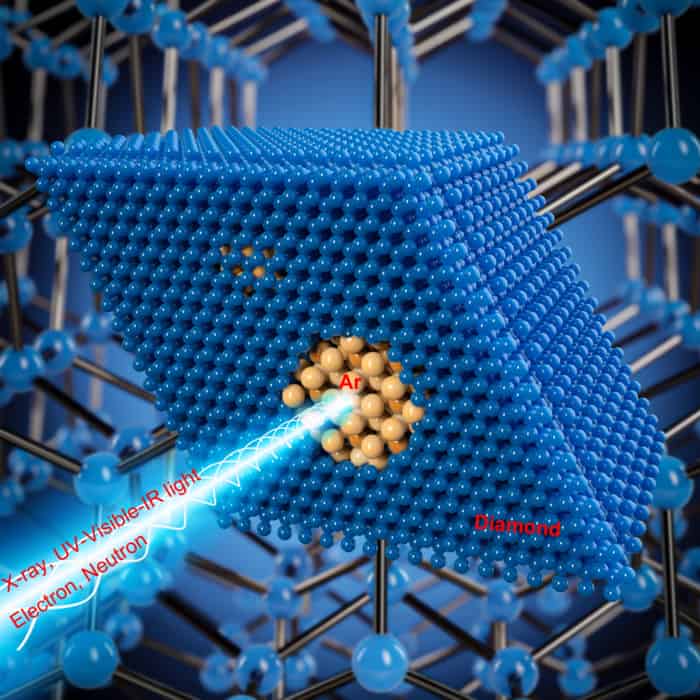
High pressures dramatically change the properties of materials, sometimes producing physical and chemical characteristics with useful applications. The problem is that these desirable properties usually disappear once the materials leave the bulky vessels that make such high pressures possible. Now, however, researchers from the Center for High Pressure Science and Technology Advanced Research (HPSTAR) in China and Stanford University in the US have succeeded in maintaining the properties of high-pressure materials outside such vessels by instead confining them in free-standing nanostructured capsules made from diamond.
In the work, a team led by Charles Qiaoshi Zeng of the HPSTAR subjected a sample of an amorphous and porous form of carbon known as glassy carbon to a pressure of 50 gigapascals (roughly 500 000 times the pressure of Earth’s atmosphere) while heating it to nearly 1830 °C in the presence of argon gas. Although the glassy carbon is initially impermeable to the argon, it absorbs it like a sponge at high pressures. The result is a nanocrystalline diamond composite that retains argon in numerous isolated pores even after it is removed from the high-pressure vessel in which the experiment was carried out.
Using high-resolution transmission electron microscopy, the team found that these pores, which they call nanostructured diamond capsules (NDCs), contain high-pressure “grains” of argon. Denise Zhidan Zeng, the lead author of a paper in Nature describing the results, says this finding is important because until now, it has been difficult to characterize high-pressure materials in-situ without resorting to probes such as hard X-rays that can penetrate the thick, strong walls of pressure vessels. “The new NDCs allow us to do away with this bulky apparatus while maintaining the high-pressure conditions and therefore the high-pressure properties of the materials being studied,” she says.
Diamond inspiration
The researchers chose to use diamond because unlike most materials, this form of carbon retains its extraordinary mechanical and optoelectronic properties at ambient pressures after it forms at higher ones. “We were inspired by natural geological diamond inclusions and found that diamond alone is strong enough to maintain high pressures within these inclusions,” Qiaoshi Zeng explains. “We therefore decided to make synthetic diamond inclusions in which high-pressure materials are preserved with a high confining pressure within a thin diamond envelope.”
The researchers found that their NDCs can maintain pressures of up to tens of GPa even though the walls of the capsules are just tens of nanometres thick. The thinness of the walls enables the team to obtain detailed information on the atomic/electronic structures, composition and bonding nature of the materials inside using modern diagnostic probes, including various techniques based on transmission electron microscopy (TEM) and soft X-ray spectroscopy that are otherwise incompatible with high-pressure vessels.
Gas and liquid samples
Traditional, static high-pressure techniques also put limits on sample sizes: the higher the pressure, the smaller the sample needs to be. Another recently-developed technique gets around this by using high-energy electron irradiation to introduce pressure on solid particles encapsulated inside nanostructured carbon such as carbon nanotubes (CNTs), but Qiaoshi Zeng points out that this technique has important restrictions. In particular, successfully sealing a target solid material particle inside CNTs and then applying pressure to it with radiation is technically challenging even under ideal experimental conditions, and is not feasible for gas or liquid samples. “In contrast, there is no such limitation for our NDCs,” QiaoshiZeng tells Physics World.

Detonation nanodiamonds could deliver nanoscale thermometry inside cells
Many materials with desirable properties have been discovered at high pressures, he adds, and these new materials would be especially attractive if it becomes possible to retain these properties under ambient conditions. “Our work is an important step towards retaining novel properties that only emerge in high-pressure materials, such as room-temperature superconductivity,” he says.
The researchers are now studying a variety of materials using the technique with the hope of preserving these high-pressure states in NDCs. “We are also looking into scaling up our high-pressure materials synthesis,” reveals Qiaoshi Zeng.
